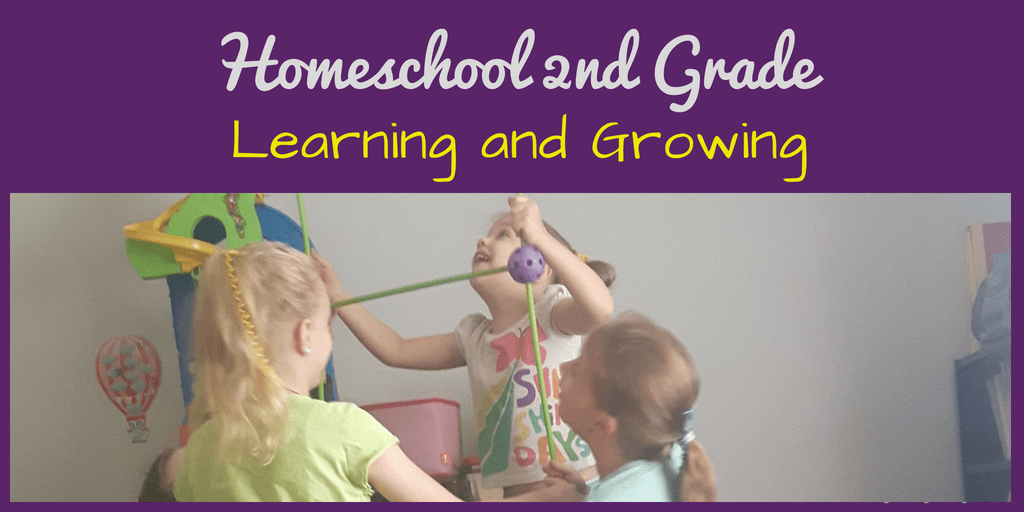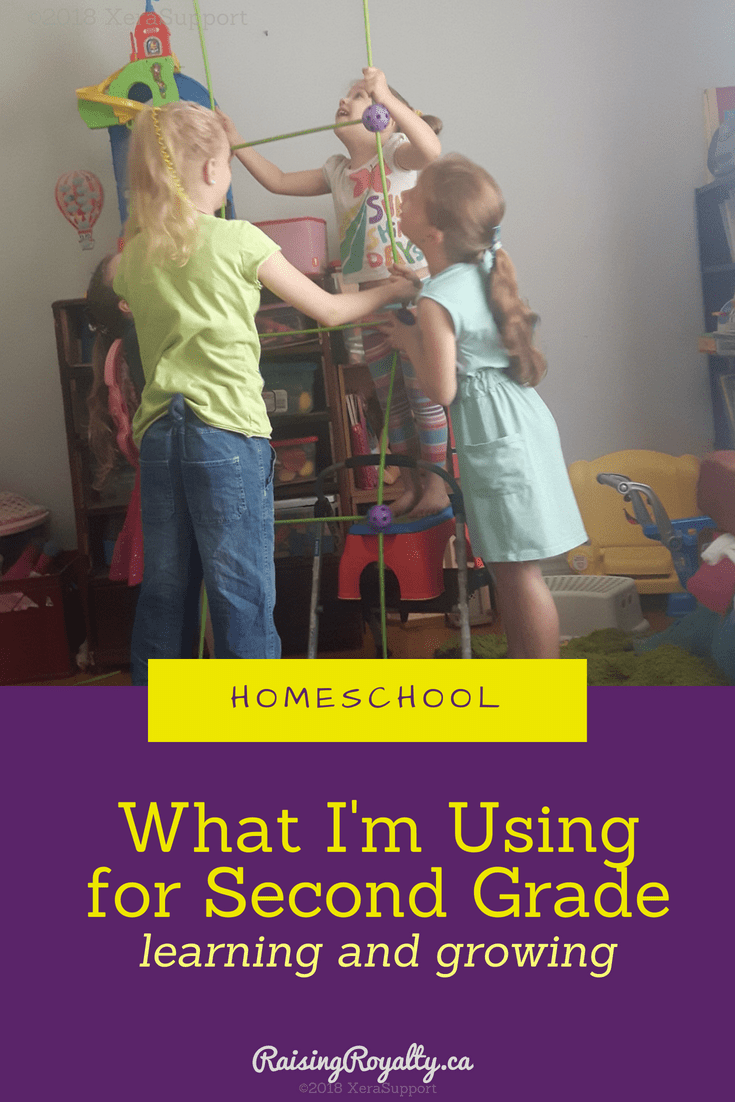
Homeschooling 2nd grade is one of the foundational years of education.
This post may contain affiliate links. Please view my disclosure policy.
By 2nd grade, most students are comfortable with the basic skills of learning – paying attention, reading, writing, following directions, and problem solving. They’ve got the beginnings of their education down, and we’re getting ready to expand their learning.
This year, I have two in 2nd grade. I have an almost-7 year old who is progressing typically, and a special needs 10 year old who is now ready for second-grade materials.
What are my 2nd grade goals?
Second grade is when I expect my children to be reading fluently, and we’re now working on different genres of reading. We also have a basic understanding of the parts of speech and different kinds of sentences, so we’ll expand that to work on paragraphs and even the beginnings of longer pieces of writing. And in math, now that we’ve got numeracy down, my goal is to make sure my children progress in arithmetic. I focus on memorization and speed, so we’ll do a lot in addition and subtraction.
In addition to the foundational skills, in 2nd grade, I start introducing more content subjects. We’ll do history studies, starting chronologically with Ancient Egypt and Mesopotamia. We’ll also continue with science, moving on to Water and Weather. And we’ll start geography, looking at map reading and basic terms. Finally, we’re going to continue our studies in French. And of course, we do some paper crafts and music lessons to make sure we have fun too.
What curriculum am I using?
We’re eclectic learners, so I try for a multi-media based approach. But we do worksheets and textbooks along with our videos, songs, computer games and flashcards. Here’s what I’m using this year:
Language Arts:
Because of the difference in my two learners, I am using two different programs for some things, and the same for other things. This is one of my favorite things about homeschooling! It’s so flexible.
Handwriting:
My special needs learner requested to learn cursive this year. While I don’t normally teach cursive, I love it when my kids ask to learn certain things. So I’m happy to accommodate her with a cursive handwriting book. I picked up A Reason for Handwriting Level 1 book and a Cursive Handwriting for Beginners book. Both books should take us to the end of the year. If not, I’ll make and print off copywork sheets for her, using HandwritingWorksheets.com
For my typical 2nd grader, I’m simply using copywork. I have some copywork books already printed off for her, and I can make more if needed. Copywork is a great way to practice handwriting. And it exposes kids to literature, history, science and of course, good grammar and punctuation.
Reading:
For my 7 year old, I’m using BJU Reading Level 2. It’s a straightforward Christian reading comprehension curriculum, with a nice mix of popular short stories, excerpts from larger books, non-fiction and poetry. And the variety of activities keeps my kids interested and interacting with the stories.
For my 9 year old, I’m using Pathway Readers, along with my Kindergartener. I’m expecting her to move through it more quickly than my kindergartener, but the simplicity of the stories will help her understand more. The workbooks are also simpler, with more multiple choice than writing responses required.
Math:
Both girls will be doing the same math program. I love the Critical Thinking Company‘s books. Last year my typical student did the Kindergarten Thinking Skills and Key Concepts book and the First Grade version. This year, we’ll do the Beginner Thinking Skills Level 1 book, for 2nd and 3rd graders.

We’ll also be doing the Grade 2 curriculum from my favorite math program Math Mammoth. I bought the entire curriculum (Gr 1-7) plus the supplementary workbooks for under $300, using special bundle discounts and sales. Because they’re digital printables, my only cost now is the cost of printing (for me, it’s approximately $3 per book!).
Science:
Again, I’m using two separate programs for both my 2nd graders. My typical student will use a series of lapbooks from some of my favorite publishers (Hands of a Child, A Journey Through Learning, etc), on the topic of plants, botany and gardening. My special needs student will be using a more workbook style, using a few Gr 2 level science workbooks I picked up at a used book sale.
I love lapbooks for my typical students. The ability to add in other resources and projects is awesome, and we can display our learning in a variety of ways. We can draw or take pictures, document experiments, and do short little reports or notetaking on shape books. And we can get really in depth on a topic.
My special needs student needs a less-in-depth approach and more repetition. So as much as I dislike teaching a spiral method on anything, for her, that’s how she learns best.
History:
My typical learner will be starting on a lapbook-based history program. I create it similarly to how I do science. She’ll start with Ancient Egypt and Ancient Mesopotamia this year. This is my 3rd year teaching this topic, so I know she’s picked up a few things already. And I already know how our crafts and experiments will go to extend our learning.
My special needs learner is going to complete our first grade social studies program, with a focus on Canadian history and geography. I like using some things from Donna Ward – Canada My Country, and Conquest and Courage, as well as some things from S&S Learning – Canadian Mapping and Canadian Celebrations. Again, it’s more workbook style than lapbook style, because of her abilities.
Geography:
While my special needs student is covering some geography as part of her social studies program, my typical student will be starting geography this year. I’m using digital printable workbooks from Homeschool Bits, a publisher on CurrClick. Her “Speedy Geography” series will cover basic terms, the major landforms of the world (deserts, mountains, oceans, continents, waterfalls), and a brief introduction to some of the more important countries of the world.
Art:
My girls love doing crafts. So in the early years, I get A Beka’s Art Projects books. Both my girls will be doing Art Projects 2 and 3 this year.
These paper-craft books are great. They need minimal prep and extra supplies, and all the instructions and supply lists are given. I’ll cut out pattern pieces and gather the supplies during my weekly prep. Then it’s pretty easy to set up and have my student do the activity independently. And that’s a huge plus when you’re a large family, with a toddler around.
Music:
This year, I’ve purchased music lesson books, and I have my keyboard (finally) set up. So it’s ready to start basic piano and theory lessons. I plan on assigning daily 15 minute practice sessions with a once-a-week 15 min lesson for my typical student. I expect she’ll play around on the keyboard and have a lot of fun, but I know she’ll pick up something about rhythm and reading music too.
She will also be starting a music history program, called Music Education for Elementary Students. This involves a reader and worksheets, lapbook elements, coloring and listening to famous pieces of classical music as we go through the major classical composers of history.
My special needs student does lots of music already, since she has an amazing singing voice. She’s in a community-based children’s choir, and I have her in private voice lessons. I’m also going to work with her on music lessons, but instead of teaching piano, we’re going to learn classic hymns.
French:
Given that we live in Canada, learning the other official language seems a natural part of our education. I’m not a native speaker, but I do have enough that I’m comfortable teaching the basics to my children, because I grew up near Quebec, the main French-language part of Canada.
For French this year, I’m using a series of workbooks: French Skill Builders Level 1, La Lecture Premier, and Comprehension des textes pour filles – a French reading comprehension program. This should give us a basic vocabulary that we can then work with to build up at least an understanding of common French phrases and grammar.
So that’s our Second Grade year.
It shouldn’t take more than 90 minutes daily for my little girls to complete their lessons. Then they’ll be free to play inside or outside with toys and their sisters, and do all sorts of play-based learning. I love that our formal work takes so little time, and we can spend a lot of time exploring and enjoying nature.
Are you doing second grade this year? What curriculum or materials are you planning to use, if any?

